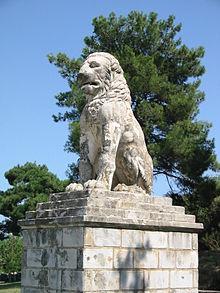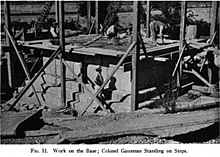Amphipolis Lion
The Lion of Amphipolis is a grave monument from the 4th century BC. BC, which was built in honor of the Admiral Laomedon from the island of Lesbos ( Mytilene ) near the ancient city of Amphipolis . Laomedon began his career as captain of a trireme and became friends with Alexander the Great . He was promoted to admiral by him and installed as satrap of Syria.
location
The monument is located on the western bank of the Strymon , two kilometers from the mouth of the river and about two kilometers south of the Acropolis of ancient Amphipolis .
history
The first knowledge of the monument dates back to 1912 or 1913, when Greek soldiers accidentally found the base of the monument during the Balkan War and reported this to the Greek archaeological service. Archaeologists Georgios Oikonomos and Anastasios Orlandos began research but had to abandon their activities when hostilities resumed.
During the First World War, the area was contested again. British soldiers of the 80th Brigade of the 27th British Division fought Bulgarian troops there in the autumn and winter of 1916. They were supported by parts of the Royal Navy. They found the base of the monument and individual parts of the lion. Attempts to transport their find towards the beach were prevented by enemy fire.
In 1929, the Greek government hired the American company Monks-Ulen to drain the Serres and Drama plains , build roads and bridges, and deepen the river bed of the Strymon to make it navigable. Many fragments of the lion statue were found during the dredging work in the river bed. Although most of the sculpture had been excavated, it took a few years for archaeologists to show interest in the find again. In the summer of 1930, Tsatsos from the Monks-Ulen Company led archaeologists Paul Collart and Pierre Devambez to the site. The two archaeologists provided the first comprehensive description. However, since they were unable to examine the lion's findings from all sides, some of their assumptions later turned out to be incorrect. They brought the statue (with reservations) with the battle of the Athenians against the Spartans in 422 BC. In connection, which found broad approval at the time. After completing their preliminary studies, they published the result. The idea of putting the individual parts of the sculpture back together and rebuilding them came from the engineers RW Gausman and J. Judge of the Monks-Ulen Company. The plan attracted the interest of then American Ambassador Lincoln MacVeagh . He called a conference to discuss the feasibility of the project with experts. The site at Amphipolis was then examined by archaeologists from the French school from Athens and the first drawings were made by Henri Ducoux. As it turned out later, these drawings were already pretty much what the lion would later look like. This was followed by publications in the archaeological press. One of the goals of these publications was to win donors for the reconstruction project. Based on the drawings and the status of the studies, the financial scope of the reconstruction of the statue was determined; Minister MacVeagh personally took care of the acquisition of patrons . Donations from Greeks, Americans and people from other nations were collected. In 1936, a generous donation from Philip R. Allen raised funding to the level needed to begin work.
The work took place under the direction of the École française d'Athènes and the American School of Classical Studies at Athens . In June 1936 the area around the original finds was intensively examined, after which work on the monument itself began.
Information about the monument and pictorial documents of the excavations and works can be found in the Archaeological Museum of Amfipoli .
The monument
For the reconstruction of the statue, the sculptor Andreas Panagiotakes was won over, who was able to free himself from his duties at the polytechnic school in Athens and the Athens National Museum . After studying the Lion of Chaeronea , Panagiotakis made a plaster cast of the statue. Reconstruction of the lower jaw proved problematic until a worker accidentally discovered a piece of it. Building the monument in its original form could not be financed. So it was decided to put the lion on a pedestal.
The stones required for this were recovered from the deepening of the river bed. Over 500 stone blocks were found, 126 of which were used for the lion's pedestal. They originally came from a bridge from the Hellenistic era. Many of these blocks bore inscriptions and were therefore not used for construction. There were enough stones of uniform size that could be used without further processing. The core of the pedestal is made of concrete, the stones surrounding the core were connected to the concrete with metal clips. Missing parts of the cuboids were filled with a special concrete to which color was added. This procedure had already been used with success in the restoration of the northern colonnades of the Parthenon in Athens. Work on the monument was finished in autumn 1937.
The lion's body is around four meters high, with the pedestal the structure measures over eight meters.
literature
- Jacques Roger: Le Monument au Lion d'Amphipolis In: Bulletin de correspondance hellénique 63, 1939, pp. 4-42 ( digitized ).
- Oscar Broneer : The Lion Monument at Amphipolis. Harvard University Press, Cambridge, Massachusetts 1941 ( digitized version ).
Web links
- The story of the lion monument (English)
- Article on the original site of the Lion Monument (English)
- Article about the lion and Amphipolis (English)
Remarks
- ↑ Ecole Francais des Athenes. Retrieved November 28, 2017 .
- ^ Homepage of the American School of Classical Studies at Athens. Retrieved November 28, 2017 .
- ^ The Pride of Amphipolis. Retrieved November 29, 2017 .
Coordinates: 40 ° 48 ′ 11 " N , 23 ° 50 ′ 33" E


